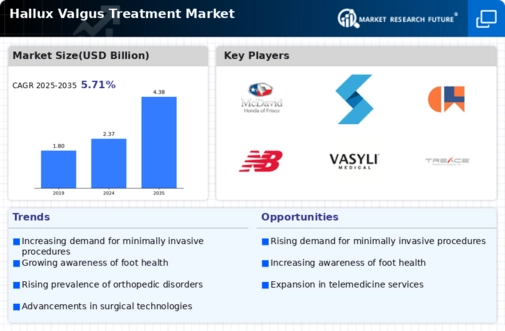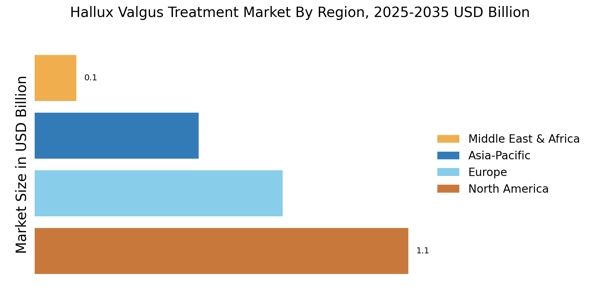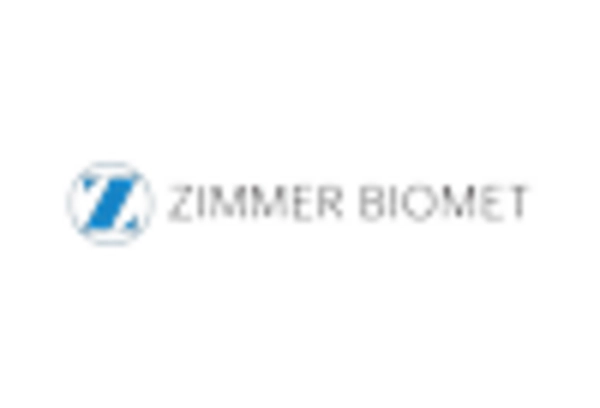Growing Geriatric Population
The increasing geriatric population is a significant driver of the Hallux Valgus Treatment Market. As individuals age, the likelihood of developing hallux valgus escalates due to factors such as joint degeneration and changes in foot structure. Current statistics suggest that nearly 60% of seniors experience foot problems, with hallux valgus being one of the most prevalent conditions. This demographic shift necessitates a greater focus on foot health and treatment options tailored to older adults. Consequently, healthcare providers are likely to expand their offerings in the Hallux Valgus Treatment Market to cater to this growing segment, thereby enhancing market growth prospects.
Rising Awareness and Education
The growing awareness and education surrounding hallux valgus and its treatment options are pivotal in shaping the Hallux Valgus Treatment Market. Educational campaigns by healthcare organizations and foot health specialists have led to increased recognition of the condition and its potential complications. This heightened awareness encourages individuals to seek timely treatment, thereby expanding the market. Furthermore, the proliferation of online resources and support groups has empowered patients with knowledge about their options, including both surgical and non-surgical treatments. As more individuals become informed about the implications of untreated hallux valgus, the demand for effective interventions is expected to rise, further driving the Hallux Valgus Treatment Market.
Advancements in Surgical Techniques
Innovations in surgical techniques are significantly influencing the Hallux Valgus Treatment Market. Minimally invasive procedures, such as arthroscopy and percutaneous techniques, have gained traction due to their reduced recovery times and lower complication rates. These advancements not only enhance patient outcomes but also attract more individuals seeking surgical solutions for hallux valgus. According to recent data, the adoption of these techniques has led to a 30% increase in surgical interventions over the past few years. As healthcare professionals continue to refine these methods, the Hallux Valgus Treatment Market is likely to experience sustained growth, driven by the increasing preference for effective and less invasive treatment options.
Increasing Prevalence of Hallux Valgus
The rising incidence of hallux valgus, commonly known as bunions, is a primary driver of the Hallux Valgus Treatment Market. Studies indicate that approximately 23% of adults aged 18 to 65 experience this condition, with prevalence increasing with age. This growing demographic of affected individuals necessitates effective treatment options, thereby propelling market growth. As the population ages, the demand for both surgical and non-surgical interventions is expected to rise. Furthermore, the increasing awareness of foot health and the availability of various treatment modalities contribute to the expansion of the Hallux Valgus Treatment Market. The combination of these factors suggests a robust market potential as healthcare providers seek to address the needs of this expanding patient population.
Expansion of Non-Surgical Treatment Options
The expansion of non-surgical treatment options is reshaping the Hallux Valgus Treatment Market. With a growing emphasis on conservative management, various non-invasive therapies, such as orthotics, physical therapy, and lifestyle modifications, are gaining popularity. Recent market analysis indicates that non-surgical treatments account for approximately 40% of the total market share, reflecting a shift in patient preferences towards less invasive options. This trend is further supported by the increasing recognition of the effectiveness of these treatments in alleviating symptoms and improving quality of life. As more patients opt for non-surgical interventions, the Hallux Valgus Treatment Market is poised for continued growth, driven by the demand for diverse treatment modalities.


















Leave a Comment